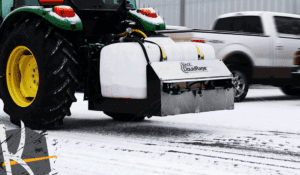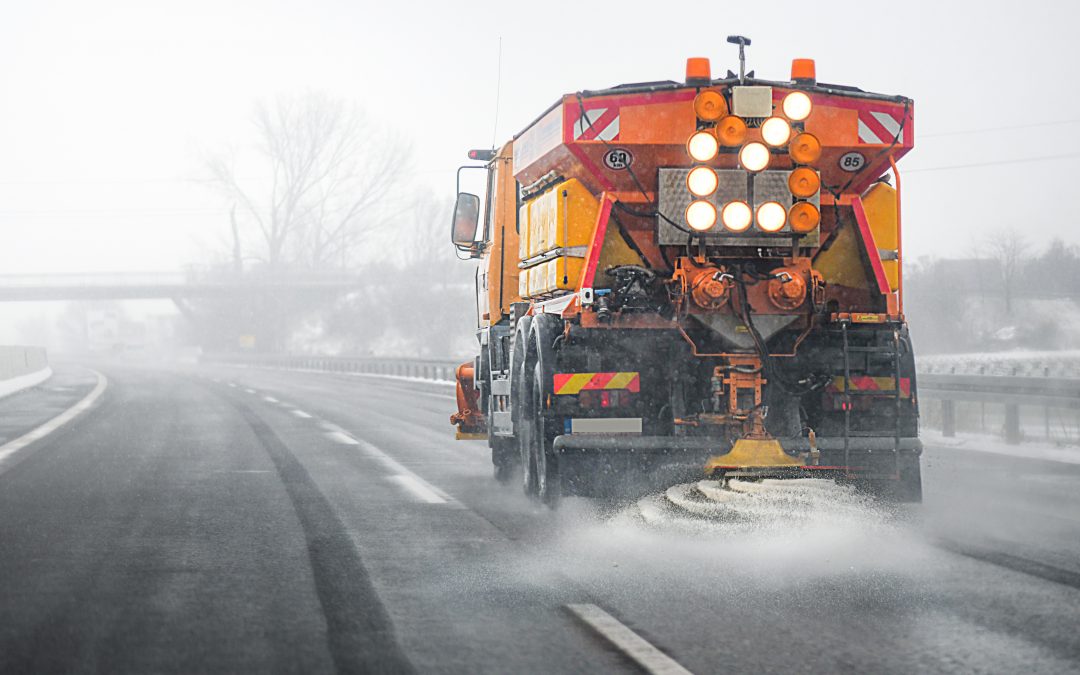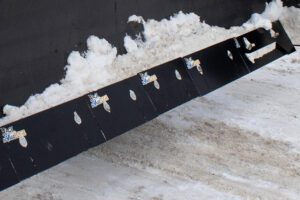There has been a lot of discussion lately about the need to reduce road salt application. In this article, we’ll discuss why road salt – also known as rock salt or halite – reduction has become a priority. We’ll also give options to accomplish that feat without sacrificing the benefits of ice control.
What are the downsides to road salt?

- Corrosion: Road salt can accelerate the corrosion of vehicles and infrastructure, including bridges and overpasses. The chloride ions in salt can promote rust and corrosion, leading to increased maintenance costs and shorter lifespans for vehicles and infrastructure.
- Environmental Impact: Runoff from melted snow containing road salt can enter rivers, lakes, and groundwater. Elevated levels of chloride in water bodies can be harmful to aquatic ecosystems, affecting fish, plants, and other organisms. It can disrupt the balance of aquatic ecosystems and harm sensitive species.
- Soil Damage: Road salt can damage soil quality, affecting vegetation along roadways. It may inhibit plant growth and alter the composition of soil, impacting the surrounding environment.
- Impact on Wildlife: Wildlife can be negatively affected by road salt. Animals may be drawn to salt-covered roads, leading to increased risk of vehicle collisions. Additionally, salt can contaminate food sources for wildlife.
- Health Concerns: High levels of chloride in drinking water can have health implications for humans. While road salt itself is not typically a direct health risk, its presence in water supplies can contribute to elevated chloride levels, which may pose health concerns for individuals with certain medical conditions.
- Aquatic Habitat Degradation: The introduction of road salt into water bodies can lead to changes in the chemistry of aquatic habitats. This can harm sensitive aquatic organisms, disrupt food chains, and impact overall ecosystem health.
According to MPR News, “Just a teaspoon of road salt pollutes 5 gallons of water – forever.”
Keep in mind that states such as New York & Pennsylvania each use in excess of 1 million tons of road salt each year – enough to pollute more than 762 billion gallons of water, respectively. That’s a lot of potential for water pollution! Both states border freshwater Great Lakes (Lake Ontario & Lake Erie) and both are home to major rivers such as the Hudson River, Delaware River and Allegheny River (which is the source for the Ohio River, the 2nd largest river in the United States).
How can I control ice with less road salt?
Efforts are being made to find alternative de-icing materials and methods to combat the detrimental side effects of rock salt usage.
Anti-Icing Liquids:

- Preventive Action: Anti-icing liquids are applied proactively before snowfall or freezing rain. By creating a barrier on the road surface, these liquids prevent the bonding of ice, making it easier to remove snow and ice accumulation during and after the storm.
- Lower Freezing Point: Anti-icing liquids often have a lower freezing point than traditional de-icing materials like rock salt. This allows them to remain effective at lower temperatures, providing ice control in more extreme cold conditions.
- Reduced Material Usage: Compared to the large quantities of rock salt often used for de-icing, anti-icing liquids can be applied in smaller amounts (up to 30 percent less). This leads to more efficient material usage, reducing environmental impact and costs associated with material purchase and application.
- Less Environmental Impact: Anti-icing liquids can be formulated with environmentally friendly compounds. They may have lower chloride content, reducing the risk of environmental damage to soil, water bodies, and vegetation compared to traditional de-icing materials.
- Improved Traction: By preventing the formation of a solid layer of ice on the road, anti-icing liquids contribute to improved traction for vehicles. This can enhance road safety by reducing the likelihood of accidents caused by slippery conditions.
- Extended Time Between Applications: Anti-icing liquids can provide longer-lasting protection compared to traditional de-icing methods. This can result in extended intervals between applications, reducing the frequency of road maintenance activities.
- Corrosion Reduction: Anti-icing liquids can help reduce corrosion on vehicles and infrastructure. They may contain corrosion inhibitors that protect metal surfaces, minimizing the impact on vehicles and infrastructure like bridges and overpasses.
- Quick Activation: Anti-icing liquids often have quick activation times. They can start working immediately upon application, providing rapid protection against the formation of ice.
- Versatility: Anti-icing liquids can be applied to various surfaces, including roads, bridges, and walkways. Their versatility allows for effective use in different infrastructure settings.
- Less Impact on Wildlife: Some anti-icing liquids are designed to have a lower impact on wildlife compared to traditional de-icing materials. This is beneficial for areas where sensitive ecosystems are present.
The use of anti-icing liquids is part of a broader effort to adopt more sustainable and efficient winter road maintenance practices.
Contour Following Snow Plows:
Contour following snow plows offer several benefits, particularly in terms of efficiency, safety, and minimizing environmental impact. Here are some advantages of contour following snow plows:
- Improved Snow Removal Efficiency: Contour following snow plows are designed to adapt to the contours and uneven surfaces of the road. This allows for more effective snow removal as the plow can closely follow the shape of the road, ensuring that snow and ice are efficiently cleared from the entire surface.
- Reduced Surface Damage: Traditional rigid snow plows may scrape or damage road surfaces, especially on uneven or curved roads. Contour following plows are designed to minimize surface damage by adjusting to the variations in the road, reducing the likelihood of scraping or gouging.
- Enhanced Safety: By closely following the road’s contours, these plows can provide better traction and control. This can contribute to safer winter driving conditions by ensuring that the road surface is properly cleared of snow and ice, reducing the risk of accidents caused by slippery conditions.
- Optimized Material Usage: These plows can optimize the use of de-icing materials. By closely following the road surface, they can apply de-icing agents more effectively, reducing the overall amount of material needed for snow and ice control by up to 50 percent. Contour following plows can help minimize the environmental impact of snow removal. They are designed to reduce the use of de-icing materials and prevent excessive scraping that can lead to the release of harmful materials into the environment. This is particularly important for protecting water bodies from contamination with road salt.
- Cost Savings: While contour following plows may have a higher upfront cost, they can result in cost savings over time. The efficiency in snow removal and the reduction in potential damage to road surfaces and infrastructure can lead to lower maintenance and repair costs.
- Versatility: Contour following plows are versatile and adaptable to various road configurations. Whether dealing with straight roads, curves, or hills, these plows can adjust to the specific contours of the terrain, making them suitable for different types of road networks.
Overall, contour following snow plows contribute to more efficient, environmentally friendly, and safer winter road maintenance practices. They are part of ongoing efforts to improve snow removal technologies and reduce the negative impacts of winter weather on transportation systems.
How do you spread anti-icing liquids?
Anti-icing liquid is utilized through the use of a sprayer. These sprayers come in many forms including truck-mounted sprayers, tow-behind sprayers, ATV or UTV sprayers, skid-mounted sprayers, handheld sprayers, tractor mounted sprayers, skid steer mounted sprayers, fixed automated systems and customized solutions. The choice of anti-icing sprayer depends on the scale and nature of the application, budget considerations, and the type of anti-icing liquid being used.
KAGE offers a small-batch anti-icing sprayer than can easily be mounted to a skid steer, tractor or UTV that will hold up to 150 gallons of brine. This is called the LiquidRage sprayer and you even have the option to add on a brine mixer to the top of the tank to increase efficiency.
Where do I find a contour following snow plow?
Contour following snow plows come in two forms – sectional cutting edges and sectional plows. For a sectional cutting edge, only the cutting edge contours to the road. For a sectional plow, the entire moldboard of the plow is divided into moving sections to allow for the contouring.
Sectional Cutting Edges: The biggest advantage of sectional cutting edges is that they retain the ability to ram into hard-packed snow piles and stack the snow without without damaging sensitive parts of the plow itself.
In some cases, such as KAGE AdvantEdge sectional cutting edge, it allows you to turn any snow blade or pusher into a contour following snow plow simply by replacing that factory cutting edge with the bolt-on contouring cutting edge. Others are proprietary cutting edge systems designed only to work with certain makes and models of plows.
The KAGE AdvantEdge is available with either Hardox steel sections or Carbide sections. There are also rubber sectional cutting edges available through other manufacturers. Those are generally proprietary cutting edges.
Sectional Plows: Sectional plows are able to follow larger contours than a sectional cutting edge due to the ability of sections of the entire moldboard – rather than just the bottom foot or less. However, when it comes to stacking and ramming, these types of plows are not nearly as robust and you’re likely to shear their pliable supports – much like a shear pin in a snowblower.
If you have further questions about ways to reduce your road salt usage, feel free to give our KAGE Innovation representatives a call. We’re happy to discuss it with you.







Recent Comments